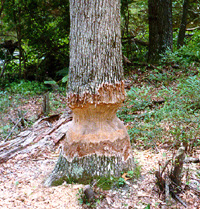|

Mammals of Pennsylvania and New Jersey

|
|
|
Beaver
(North American)
Background Information
The North
American beaver is second largest rodent
in the world. A rodent is a gnawing animal. Beavers are located
throughout most of North America. Throughout history, it has
been trapped for its fur. However, early settlers also ate
beaver as part of their diets. During the 1970s, beaver trapping
began to be controlled. People can get a license to trap beavers
only during a trapping season. Beavers help our environment
by creating a system of small dams and canals that helps to
stop flooding, that creates marshland, and
that stops soil erosion. |
 |
Life
Cycle
Beavers
pair for life. They start having young by the time they are
three years old. It takes more than 3 months for baby beavers,
or kits to develop. Beavers can have up to
8 kits, but four is the usual number. Kits are born in a "room"
in the beaver's home known as a lodge. Young beavers are born
with fur and can swim soon after birth. The mother will nurse
her young for 6 weeks, then the kits have to start eating
regular beaver food. The young will stay at the lodge for
up to two years. Then they leave home and find a new area
to live. They leave a smell from scent glands to mark their
new home area. Beavers live between 15 to 21 years. |
Habitat
& Home
Beavers
are found in streams, rivers, and lakes. They use their large
front teeth to gnaw through trees and branches. They use them,
along with sticks, mud, and stone to make dams in streams.
The dam causes water to back-up and flood the land behind
the dam. The result creates a marshy type
of land. Other fish, insects, birds, and plants begin to take
up housekeeping.
Beavers
do most of their work at night. Within the dams, beavers build
lodges that have several underwater entrances.
They also build canals leading to their homes. This makes
it easier to drag small trees and branches to their lodges.
They store this food for the winter months.
Beavers
do not hibernate. However, they spend most
of the winter months in their dry lodges. They come out only
to eat tree branches they have stored. Their winter months
are spent in darkness because no light enters their lodges.
|
 |
|
Diet
A beaver's
diet is simple. It is made up of bark and twigs from trees
such as oak, elm, maple, poplar, and birch trees. Because
of their diets, they are known as herbivores,
or plant eaters. |
|
© Dr.
Randall Pellow, 2005 |